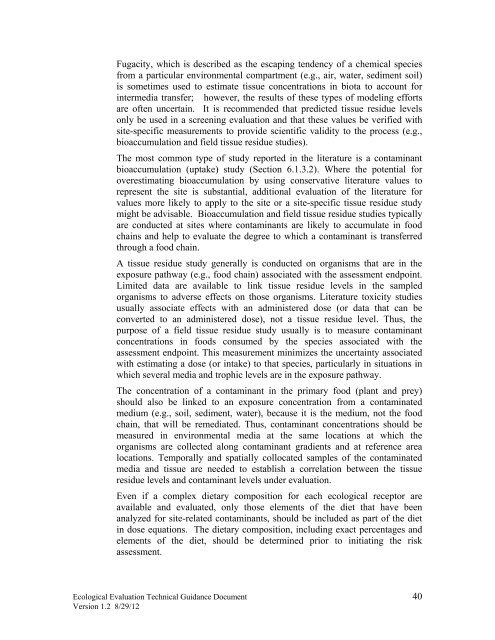Ecological Evaluation Technical Guidance - State of New Jersey
Ecological Evaluation Technical Guidance - State of New Jersey
Ecological Evaluation Technical Guidance - State of New Jersey
- No tags were found...
You also want an ePaper? Increase the reach of your titles
YUMPU automatically turns print PDFs into web optimized ePapers that Google loves.
Fugacity, which is described as the escaping tendency <strong>of</strong> a chemical speciesfrom a particular environmental compartment (e.g., air, water, sediment soil)is sometimes used to estimate tissue concentrations in biota to account forintermedia transfer; however, the results <strong>of</strong> these types <strong>of</strong> modeling effortsare <strong>of</strong>ten uncertain. It is recommended that predicted tissue residue levelsonly be used in a screening evaluation and that these values be verified withsite-specific measurements to provide scientific validity to the process (e.g.,bioaccumulation and field tissue residue studies).The most common type <strong>of</strong> study reported in the literature is a contaminantbioaccumulation (uptake) study (Section 6.1.3.2). Where the potential foroverestimating bioaccumulation by using conservative literature values torepresent the site is substantial, additional evaluation <strong>of</strong> the literature forvalues more likely to apply to the site or a site-specific tissue residue studymight be advisable. Bioaccumulation and field tissue residue studies typicallyare conducted at sites where contaminants are likely to accumulate in foodchains and help to evaluate the degree to which a contaminant is transferredthrough a food chain.A tissue residue study generally is conducted on organisms that are in theexposure pathway (e.g., food chain) associated with the assessment endpoint.Limited data are available to link tissue residue levels in the sampledorganisms to adverse effects on those organisms. Literature toxicity studiesusually associate effects with an administered dose (or data that can beconverted to an administered dose), not a tissue residue level. Thus, thepurpose <strong>of</strong> a field tissue residue study usually is to measure contaminantconcentrations in foods consumed by the species associated with theassessment endpoint. This measurement minimizes the uncertainty associatedwith estimating a dose (or intake) to that species, particularly in situations inwhich several media and trophic levels are in the exposure pathway.The concentration <strong>of</strong> a contaminant in the primary food (plant and prey)should also be linked to an exposure concentration from a contaminatedmedium (e.g., soil, sediment, water), because it is the medium, not the foodchain, that will be remediated. Thus, contaminant concentrations should bemeasured in environmental media at the same locations at which theorganisms are collected along contaminant gradients and at reference arealocations. Temporally and spatially collocated samples <strong>of</strong> the contaminatedmedia and tissue are needed to establish a correlation between the tissueresidue levels and contaminant levels under evaluation.Even if a complex dietary composition for each ecological receptor areavailable and evaluated, only those elements <strong>of</strong> the diet that have beenanalyzed for site-related contaminants, should be included as part <strong>of</strong> the dietin dose equations. The dietary composition, including exact percentages andelements <strong>of</strong> the diet, should be determined prior to initiating the riskassessment.<strong>Ecological</strong> <strong>Evaluation</strong> <strong>Technical</strong> <strong>Guidance</strong> Document 40Version 1.2 8/29/12
















